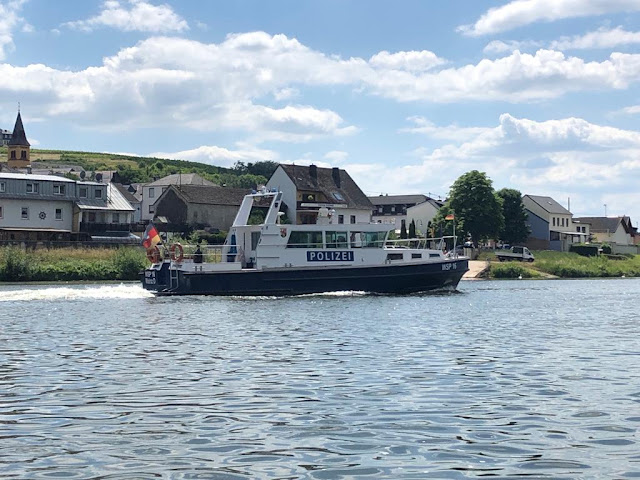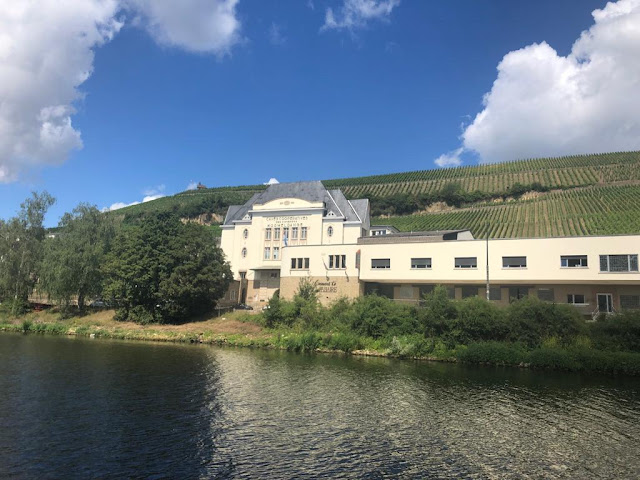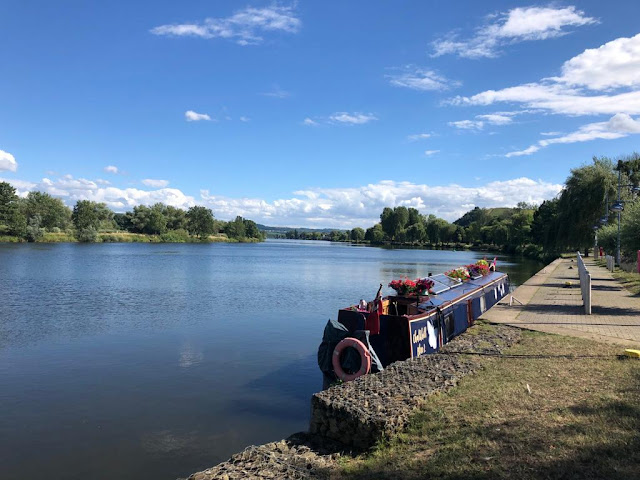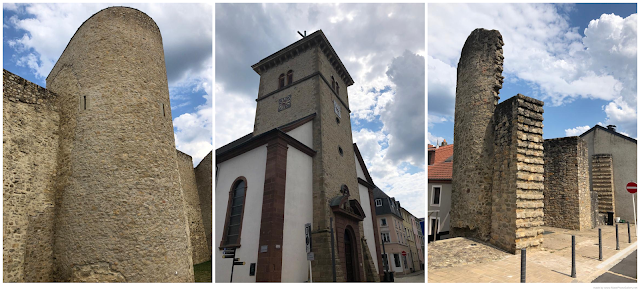 |
| Calm morning on the Moselle at Bech-Kleinmacher |
Before we went out on Wednesday, we watched a German police boat on its way past hoping they weren’t going to stop to check our documentation and equipment. We’ve not been boarded in all the time we’ve been in Europe, but we meet many people who have so we count ourselves as lucky so far. A little later on it came back tailing a commercial and we could see two of the policeman who'd obviously boarded it and were in its wheelhouse leafing through bundles of papers.
 |
| German police boat |
We had an easy morning walking around Wasserbillig, and hearing some French being spoken instead of German made us feel like we'd arrived home after being away on a foreign holiday. Even the town hall was a mairie rather than a rathaus.
 |
| Wasserbillig mairie |
The school was near the mairie where we were reminded how lucky children in Luxembourg are because, starting at primary school, they learn to speak French, German and English on top of their native Luxembourgish. A large vertical mosaic stood alongside our quay depicting the State of Luxembourg with its 12 cantons and coats of arms. It consisted of 56 mosaic plates, which in turn consisted of individual mosaic stones.
 |
| Mosaic of Luxembourg |
We assumed the work was a mosaic in homage to when the Moselle was part of the Roman Empire. As well as many vestiges of their past preserved along the Moselle valley there is still the living past in the form of the vineyards; the Romans first planted vines along the Moselle over 2,000 years ago.
Ian and Helena had explained to us the previous evening about fuel tourism and how there’s usually a constant stream of cars coming into the town from Germany and France to take advantage of the cheaper fuel. Recently, there has been reverse fuel tourism due to the subsidies that both Germany and France have applied to the pump prices because of the rising cost of fuel. Another thing we didn’t know was that Luxembourg regulates the price of fuel and it’s the same price at all outlets. I assume fuel tourism was the reason a small town like Wasserbillig had 10 filling stations one after another. Not only was that a strange sight but also the fact that they all had exactly the same prices.
We spent much of the afternoon in a bar on the German side of the
river at a place called Oberbillig as we could see from our boat that it was in
the shade. With very few bridges across
the Moselle in Luxembourg we had to take the ferry over, being extra careful of
where Buddy trod as it was a hot day, and the deck was metallic. While waiting for the ferry we stood by a
sculpture of a fisherman and a boy next to a bucket of fish that a cat was
trying to steal. Buddy had a good sniff
of the cat before working out that it wasn’t alive.
Sitting at the bar we had a good view across to Wasserbillig and
the charming looking trains of Luxembourg with their bright green doors clearly
showing where bikes can be taken on board.
We hadn’t realised but all public transport is free in Luxembourg in an
effort to keep cars off the roads.
.jpeg) |
| Train crossing the river Sûre and us moored on the Moselle |
.jpeg) |
| Wasserbillig waterfront |
 |
| Ferry arriving to pick us up |
Later on we went to Ian & Helena’s house, also on the waterfront, for a most enjoyable evening where as well as catching up on our respective lives and having some great food we were treated to some excellent samples of the local wines.
THURSDAY 30 JUNE
We left for Grevenmacher after breakfast and were soon passing Ian
& Helena’s house at the far end of town.
With four floors and a roof terrace they have some lovely views along
the Moselle.
 |
| The view from Ian & Helena’s and I’m not referring to the boat! |
A little further on a dredger was operating and although there was plenty of room to pass on either side, we still checked the boards it was displaying to make sure we were passing on the correct side.
 |
| Red & white oblongs indicate the correct side to pass |
It took less than an hour to reach our destination and we moored at the shallow end of the empty quay which was alongside an outdoor swimming complex.
 |
| Moored at Grevenmacher |
We walked along the riverfront with its restaurants full of lunchtime diners to the tourist office where we picked up a leaflet on the town’s historic trail. We were quite near the next lock, so we went to have a look to see how we would cope with it. We were now going uphill so needed to make sure we would know where we could tie up while waiting for the locks to be readied. Another concern was that many of the locks are in pairs but, unlike the Saar where the smaller looks at 40 metres were an ample size for us, these smaller locks were only 18 metres long and designed for river cruisers. As our boat is 18 metres long with the front and rear fenders down there was a slight concern we might end up in a little difficulty if we were put in a small lock.
The lock approach didn’t look narrowboat friendly at all with
nowhere for us to tie up if we needed to wait.
The approach walls were far too high for us to get a line up to, so it’ll
be a case of hovering in the channel while we waited. As it happened two cruisers were on their way
up and they were doing exactly that. We didn’t
expect to get to the lockside itself as the complexes are always secured from
the public. We were lucky though and a man was walking towards the control tower, so I called out to him asking
if he was an éclusier. He confirmed he was and came over to
us and after a short discussion on our potential issue he switched to perfect
English and put our minds to rest saying we should use the large locks.
After lunch we set out on the historic town trail. It was slightly disconcerting that the map
had no street names and wasn't aligned to north. We didn’t let that concern us as the town wasn’t very
big and the sights looked relatively close to each other.
 |
| No street names |
The map showed the outline of town walls so we immediately thought that that would help us keep our bearings. That would have been great if any of the walls were still in existence! With temperature back in the low 30s we took it fairly slowly and the afternoon got sultrier as the clouds started building for a forecast rainstorm later in the evening.
The trail was one of those that when we arrived at many of the
sights, the blurb started with words such as, ‘Here stood the market cross’ or ‘This
gate was demolished in 1837’. Of the original walls we found the remains of
two towers and all that remained of the castle was one of its towers which was
reused as the belfry of the church in 1782.
Many of the streets were very narrow, especially those running just inside what were the town walls.
We saw two bronze sculptures, the first was sculpted by a Guy Charlier
in 1954 and sat in the centre of the shopping area. It depicted two spies carrying a bunch of
grapes, apparently a biblical reference.
The second was of a local blind guy called Blannen Thies who was a
wandering minstrel and lived in the second half of the 18th
century.
At one point we were taken to the old town hall but there was no
indication as to its age or current use.
 |
| An old mairie |
Our spirits were raised somewhat when we were directed to a lavoir but on arrival we found that the original lavoir had long since disappeared. A replica has been built so at least an educational record remains.
The wind got up in the early evening, presaging a good storm, and even the swimmers and sunbathers must have thought one was coming as the area quickly emptied. The storm never arrived but we did have a short period of light rain.
On Thursday we cruised five km through no locks.
FRIDAY 1 JULY
For us we had a long cruising day ahead on Friday, so left Grevenmacher
after Karen returned from her run. The
forecast was for a cloudy and much cooler day in the low 20s which is always a
boon on a long cruise. We were only a
kilometre away from the first lock so, as agreed with the éclusier the previous
day, I radioed ahead to ask for the large lock to be set. We had to wait for a commercial to come down
but as soon as he emerged, we were able to go in. A sign at the lock approach indicated that
the small lock was for boats of a maximum length of 18 metres (our length) with
a width of 3.30 and water draught of 1.50 metres.
When we reached the top the éclusier had come down from his control tower and was standing at the lockside obviously keen for a chat. It goes without saying that when he realised we didn’t know Luxembourgish he offered to speak in French, English or German . We’ve noticed that some locks on the Moselle and Saar have arms that are raised and lowered in front of the bottom gates but haven’t worked out why. He was able to explain that they are lowered for large boats to ensure they don’t hit the gates before tying up.
 |
| Arm lowering on Grevenmacher lock |
The river went through some beautiful countryside alternating between steep rocky slopes, vineyards and woodland.
We passed several Moselle wine houses and, as expected in a
wealthy country, some amazing villas.
 |
| Riverside winery in Machtum |
A new quay was under construction at Ehren where we pulled up for lunch. It looked like it was going to be a really pleasant place to stop over when the works are completed.
 |
| Lunch on the new quay at Ehren |
We had to wait for a boat to leave the shallow lock at Stadtbredimus so we tried to hover away from the side as it looked quite weedy at the water’s edge. It was a never-ending battle as quite a stiff breeze had suddenly sprung up. As we made our way into the empty lock, I could feel that we had picked up quite a bit of weed on the prop, an unusual occurrence on a river. Going into the weed hatch wasn’t really an option at the bottom of the lock so we planned on pulling up as soon as we came out.
 |
| Struggling to keep to the lock side |
We had another friendly éclusier and he even asked if he could
take pictures of us. When we exited, we
tied up to a bollard at the top lock approach to sort out the weed hatch but
waited for a Dutch commercial to pass us on its way into the lock before I set
about clearing the weed. I never got
that far as our friendly éclusier used the loudspeaker system telling us to
move on and that stopping was not allowed.
It felt a bit comical as I could only communicate by radio to explain we
had a problem, and his responses could be heard by the world. He was so insistent that we limped on and
pulled up at a ferryboat pontoon to clear the prop.
The plan had been to stop for the day at Remich but when we arrived the quayside was packed with tourists as were the bars and a small fairground. It really looked like it was going to be a busy evening and coupled with several large party type river cruisers we decided to move on. The next quay was only a couple of kilometres away at Bech-Kleinmacher and was empty and quiet, so we tied up there for the night.
 |
| Moored at Bech-Kleinmacher |
We were watching the river traffic through the side hatch during the evening when a passing day boat asked if they could pull up for a chat. There were five guys on a stag weekend being driven by the boat owner and even though I had a beer on the go they were insistent they supplied more. We ended up having a good chat about Luxembourg as well as their and our lives before they went off to find a bar to carry on their stag weekend shenanigans.
On Friday we cruised 24 km up two locks.
SATURDAY 2 JULY
We’re certainly enjoying being in Luxembourg and finding that everyone
we’ve spoken with has been very friendly.
Of course, we’ve had a lot of people just coming up to us to ask
questions, especially those who’ve never seen a narrowboat outside of the
UK. Part of the friendliness is the fact
that they are keen to speak any of their languages with no loss of pride that
they’re not speaking their native Luxembourgish as seems to be the case with
some multi-lingual Europeans. Before we
left Bech-Kleinmacher we had a look around the village and also walked to the
top of the hill overlooking it.
 |
| Avenue to the church |
At the church we thought we were some way above the Moselle so were shocked to see these flood level markers on one of the houses next to it:
As with other places we’ve stopped at in Luxembourg the houses
were generally large, the streets clean and clear of litter and, like French
villages, had very little traffic.
 |
| Bech-Kleinmacher main street |
We followed a road to the top of the hill behind the church and came out at a Roman burial chamber with wonderful views in all directions. The original chamber was found in 1950 and the reconstructed building protecting the chamber was built in 1987. It has a glass floor allowing a view of the remains of the chamber below.
.jpeg) |
| Vineyards above Bech-Kleinmacher |
We found a different route back following a footpath that zigzagged down the steep hillside. Back on board we were just about to leave when a speedboat driven by a guy who lives in Luxembourg City stopped by to talk with us. We learnt a bit more about life in Luxembourg and he about living on the waterways in the UK.
Soon after leaving we stopped at the marina at Schwebsange for
diesel. This was the first time since
leaving the UK that we’ve taken on fuel in a marina, and I must say it was a
lot simpler than wheeling jerry cans on trolley to a fuel station. Usually, marinas are more expensive than
vehicle fuel stations but being in Luxembourg all outlets have to charge the
same price - €1,85 per litre. While
filling up, the capitaine came along to ask if he could take photos of the boat
and so did a couple of his workers as it was the first time they’d seen a
narrowboat on the Moselle. I also took
the opportunity to learn a few Luxembourgish words.
As we went back out to the river our speedboat friend reappeared
this time with a passenger. They cruised
alongside us for a while chatting away before speeding back off in the opposite
direction:
It wasn’t long before we arrived at Schengen and were mooring up
on the short quay there which, as we've found at every Luxembourg quay we've stopped at, was empty.
 |
| Moored at Schengen |
Every town and village we’ve passed in Luxembourg has its name in a large sign by the riverside such as where we left in the morning, and they have all been in the same bold style.
Strangely, when we arrived at Schengen the signboard was of a
completely different style:
We were moored next to a bridge across the river so walked over it
into Germany and up through a vineyard for a look over France, Luxembourg and
Germany.
 |
| Schengen quay from the bridge |
The three countries meet at the middle pier of the bridge which we could see from the boat:
Looking at the picture above, Germany is on the far bank, we are
moored in Luxembourg and the lock just beyond the bridge is in France. We knew that the Schengen agreement was signed
in 1985 in the town because of the meeting of the three countries. What we didn’t know was that it was signed on
board the Princesse Marie-Astrid, a boat we’ve come across a couple of
times recently on one of its cruises.
 |
| Schengen agreement signed on board on 14 June 1985 |
Later in the afternoon we walked down to where the Marie-Astrid was moored for the signing of the original agreement and others since then. Having not done any research beforehand we were surprised to find an exhibition hall and various displays of artwork. We found the exhibition hall fascinating and have to admit that we both learnt quite a bit about the history, functions and operations of the EU.
One of the displays contained a passport from each EU country together
with some facts and figures about that country.
At least the GB information was still on display even though rather
obscured by a crass sticker.
An area outside the centre displayed the national flags of the EU
members. Alongside each flag was a large
brass plaque with the name of the country engraved upon it. Try as we might we couldn’t find where the
British flag had been. We even went back
into the centre to ask if they could tell us.
Unfortunately, the lady on duty had only recently started working there so didn’t
know.
 |
| No sign of where the Union Jack had been |
There was a large piece of work by Martin Rehrl, an Austrian sculptor
who works in stainless steel, that we found rather poignant.
 |
| Symbol of unity and solidarity |
Two sections of the Berlin wall were on display symbolising the creation and removal of borders:
 |
| Another monument in memory of the original signing |
I know if we’d have thought about it, we would have expected tourists of many different nationalities to be visiting Schengen. It certainly was an education for us and probably for many of the families who were there too.
Our mooring was in the shade by early evening, so we were able to
sit outside comfortably, watching the tourists and also a local Luxembourg
half-marathon. The runners had started
at Remich, crossed over to Germany and then back to Luxembourg over the
Schengen bridge which was the half-way point.
On Saturday we cruised seven km through no locks.










.jpeg)




No comments:
Post a Comment